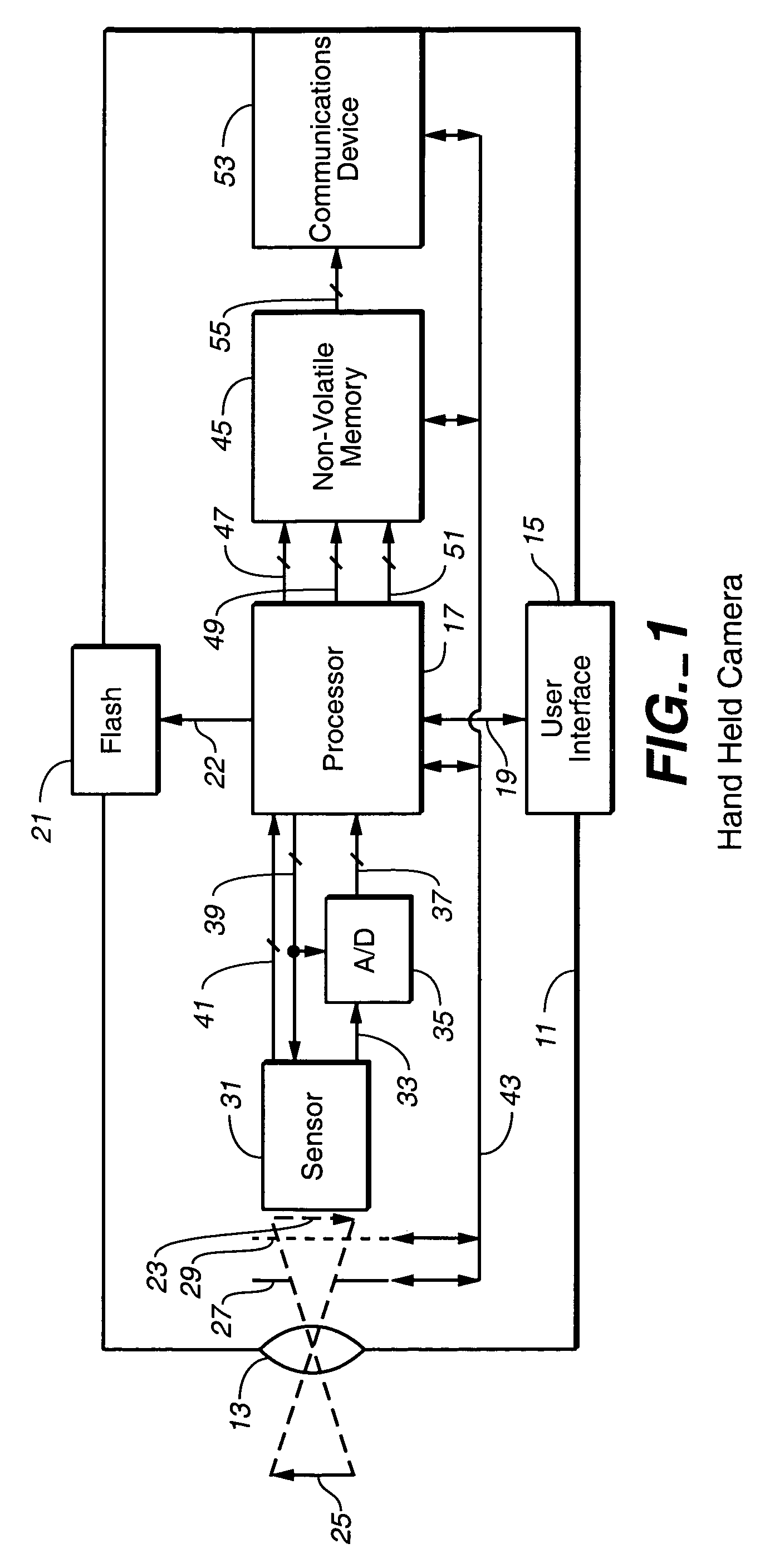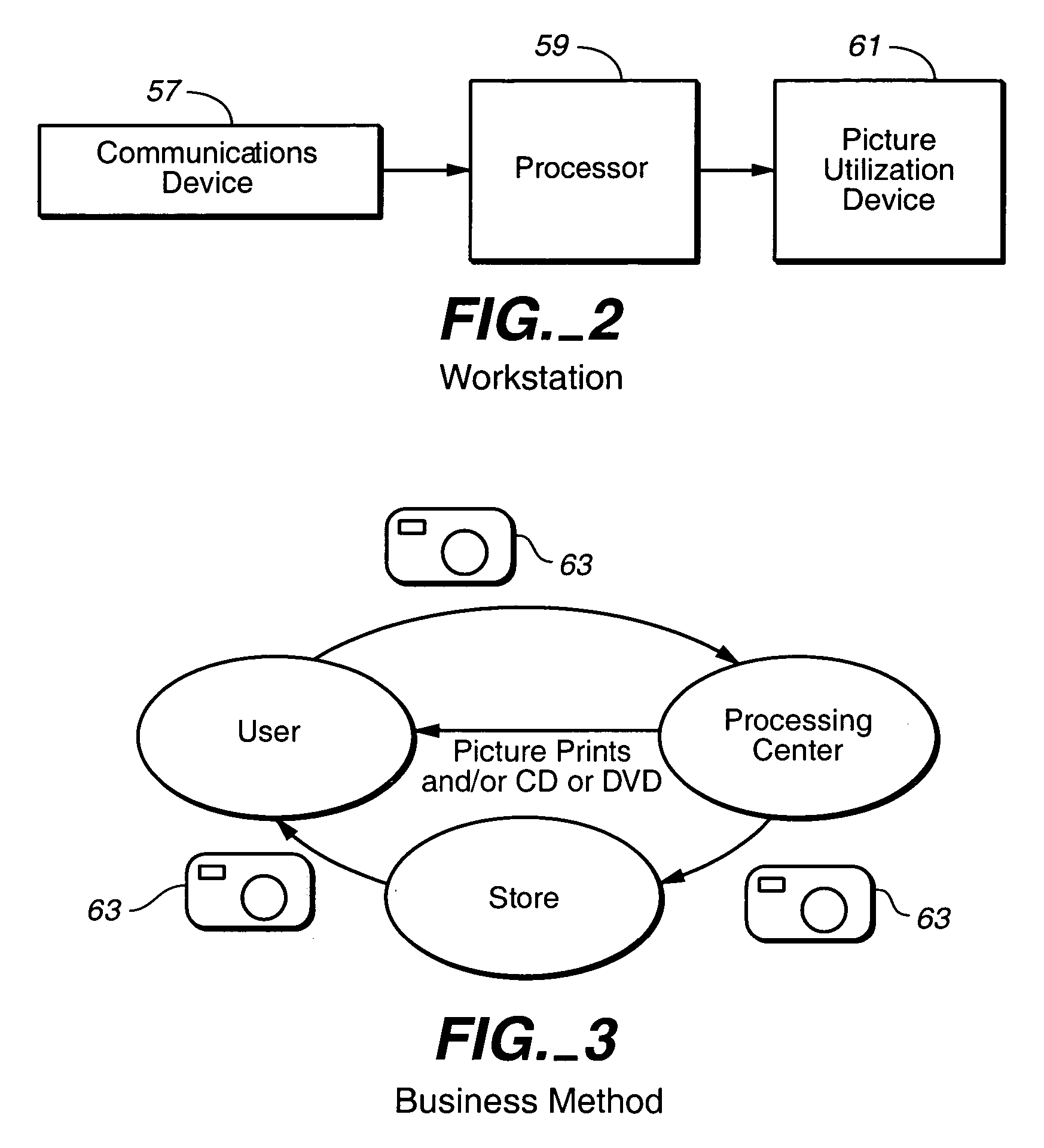[0008]According to one principal aspect of the present invention, the process of converting the
digital image from the sensor in the camera to the format that is ultimately delivered to the
end user is partitioned between the camera processor and a
data processing workstation, such as a workstation in a commercial service center, in a way that minimizes the amount and complexity of processing done in the camera. It does this by transferring a majority or all of the image processing traditionally performed within digital cameras to the workstation. Raw or nearly raw
digital data of the
signal output of the
image sensor, or a compressed version of it, are acquired and stored within the camera and then transferred to the workstation. In addition to this image data, various support data may be stored along with the image data within the camera in order to facilitate processing by the workstation to which the data are transferred. Such support data can be derived from a prior camera calibration, from an additional sensor within the camera, from a second image taken under different conditions or obtained from an analysis within the camera of the image data itself. In addition to reducing the complexity and cost of the camera in this way, the workstation can also provide more powerful processing that has been considered to be too costly, too physically large, too
time consuming or too power consuming to be included in a digital camera. This results in pictures with significantly improved quality being obtained by the end-user with a digital camera of reduced complexity and cost.
[0009]According to another principal aspect of the present invention, image
digital data is compressed within the camera in real-time and in a single-pass through the acquired sensor data in a manner that also reduces the complexity and cost of the digital camera. The method of compression implemented in the camera's processor is not constrained by the convention of compliance with a standard, such as the Joint Photographic Experts Group (
JPEG) standard, since the workstation can be complementarily configured to receive the compressed data from such a camera, yet the advantages of
JPEG compression can still be realized. The entire
digital image frame received from the sensor need not be stored in an
image frame buffer memory, prior to compression, as is commonly done in most digital cameras. Instead, only a small portion at a time of the digitized data of an
image frame needs to be stored prior to compression. By this means, a separate
digital memory integrated circuit chip normally dedicated to storage of the image prior to compression can usually be eliminated from the camera, thus reducing its complexity, eliminating operational constraints imposed by the separate memory and reducing the manufacturing cost. If
temporary storage of the entire
image frame is required at all, it is only of the
reduced size compressed picture frame, not the much larger amount of data of the image frame prior to its compression. Thus, the total need for temporary image data storage can be reduced considerably. At the workstation at the service center or otherwise, the compressed pictures are retrieved from the non-
volatile memory in the digital camera used to store the captured image work product, and decompressed. After decompression, the workstation completes the processing of the image data to optimize picture quality and correct for imperfections in the camera, all the processing that commercial digital cameras now do, as outlined above, and more. The decompressed and processed image data is then put into a form for utilization by a color printer, for writing onto a CD or DVD, or some other end use. When preparing the data into standard format files for writing onto a CD, the workstation processes the pictures by compressing the data into a standard, such as the
JPEG format standard.
[0010]According to a further aspect of the present invention, a digital camera may be configured to take at least two pictures of the same scene in rapid succession, and then process the data of the two images to produce a
single image of the
common object scene that has a quality that is better than the quality of either of the acquired images, that corrects for defects in the acquired images and / or which compensates for limitations of camera. For example, the effect on the image of defective pixels of the
image sensor can be eliminated when the image on the camera sensor is shifted by at least one pixel between the two exposures, an extremely small shift that certainly occurs between two successive exposures with a hand-held camera. Data of portions of one image containing the effects of defective sensor pixels are replaced by data of the same portions of the object scene acquired by the other image, which, because of the camera motion between pictures, are acquired by different sensor pixels. The effects of
fixed pattern noise of the sensor, the camera
optics and the electronic
system can corrected in the same way. An
advantage of making these corrections in this way is that they are dynamic; that is, changes in the sensor or
optics over time are corrected automatically without having to separately measure them. Another example is increasing the
light sensitive dynamic range of the camera sensor by acquiring two or more images of the same object scene under different
exposure conditions and then combining them. This allows restoration of details of portions of an acquired image that are either predominately dark or bright because of sensor pixels being saturated. Further, image details that are blurred by a camera moving during
exposure may be sharpened by making two such exposures in rapid succession and then processing the data of both images with an inverse smearing
algorithm.
 Login to View More
Login to View More  Login to View More
Login to View More 


